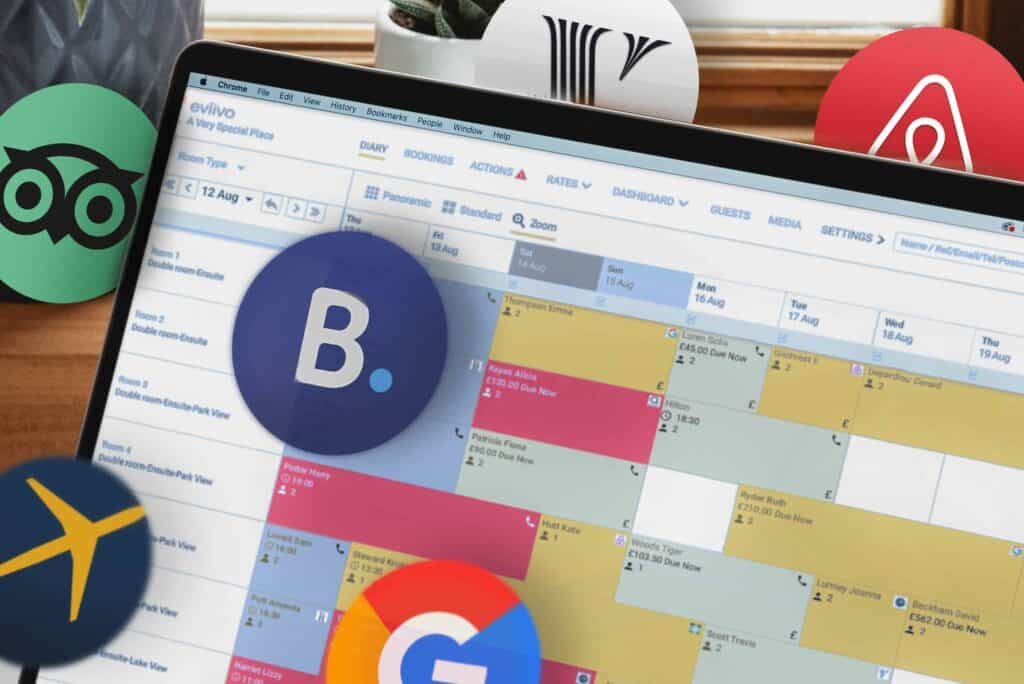It’s hard to deny that partnering with online travel agencies (OTAs) – such as Airbnb, Booking.com, Expedia and Google – is the way to get your property exposure in today’s competitive market. After all, according to a 2022 report by Phocuswright, OTAs held almost 40% of the total online travel market.*
By being seen on the major booking sites, independently-owned properties like yours can unlock extraordinary levels of visibility.
The key to maximizing the benefits of integrating with different OTAs takes some thought and effort. Anybody who’s tried managing multiple OTAs manually knows how challenging it can be to decide on your pricing structure or to learn the policy requirements for each site. There’s also the constant risk of overbookings to contend with when bookings on one property can come from multiple channels.
Don’t worry! Below are our “must-knows” to help you fully leverage the marketing power OTAs provide. We’ll go step-by-step — from the processes you want to nail down before your listings go live to impressing your guests on arrival to boost your OTA success.
1. Understand the Basics: Commission-based OTAs vs. Metasearch engines
Broadly speaking, there are 2 main channels you can use when seeking online bookings. It’s important to be aware of the distinctions between them and what they mean for your business before you start using online travel agencies (OTAs).
Commission-based OTAs are the most common model – think Booking.com, Expedia, Airbnb, and VRBO. They work like this. Guests can book their stay at your property on the OTA website. As the property owner, you – or sometimes, both you and the guest – pay a percentage on each booking that is made on the OTA website. That percentage is pre-set by the OTA.
As we’ve established, the main benefit of working with OTAs is to amplify your online visibility. This is especially true if you go with the major players we listed above. But there are also niche and regional travel sites you should consider. In fact, that same Phocuswright report showed that smaller OTAs collectively rose 60% in the span of just one year.
Meanwhile, metasearch engines operate predominantly on a pay-per-click model. This means you pay for the visit to your site from the engine regardless of whether the user ultimately makes a booking. Examples of metasearch engines include Google, Trivago and Kayak.
Metasearch engines are useful for advertising your own website alongside the OTAs that also use them. As some metasearch engines enable a simpler commission model for independent accommodations, you can use them to really draw in visitors and drive more direct bookings.
You may find one of these two models more appealing than the other (especially if you like the sound of commission-free direct bookings via the metasearch engine). Our advice is to take advantage of both OTAs and metasearch engines. Individually, they’re helpful in generating more visibility. Used together, they’re your ideal way to get the optimal number of bookings. And that’s the real name of the game here, right?
2. Nail Down Your Policies
Just as you want to create seamless experiences for your guests, you want your policies and your preferred OTAs to interact as smoothly as possible. The fact is, each OTA has its own specific policies, spanning everything from the way they collect your guests’ payments to their guidelines on what you can list about your property on their site.
Rather than work backwards trying to accommodate each individual OTA’s policies, you may want to set your own policies first, then see what that OTA supports.That way, even if you have to adjust certain policies for a specific OTA, you remain in control of your direct bookings.
Having one set hub for all your policies also helps keep you in control. Ideally, you should have access to a channel manager. This gives you one centralized platform to collate your policies and then automatically send any updates to your opted-in OTAs. You also get to view all policies (your own and the OTAs’) in one place. This way, you don’t lose any time having to check each individual OTA’s policies against your own, or updating each listing manually as your policies evolve.
Data from OTAs can also provide insights you can use to develop your policies. For example, when we conducted a survey of 3,000 properties, we found that ones without any minimum length of stay (MinLOS) restrictions make 43% more revenue from the major travel websites. That’s data we can use to confidently say that you should always offer a 1-night stay on your OTA listings!
3. Keep Your Pricing Consistent
Your pricing is as crucial as your policies – and it’s another area where consistency is key. One common mistake property owners make when using multiple OTAs is to offer different rates on different sites. This may offer short-term benefits but it could hurt you in the long run, when the OTAs you’ve put at higher rates find out; your ranking in their algorithm could plummet! Our advice is to always use the same rates on each OTA you list on. (And for more on improving your ranking on OTA search results, check out our guide to OTA SEO.)
So, how do you determine those rates in the first place? This is another area where you can use the OTAs to your advantage. Conduct searches on your chosen OTAs for your property’s local area. What rates are similar properties going for? OTAs offer a wealth of comparative info to help you develop a competitive pricing strategy. You can get more of our top tips on pricing here.
Of course, pricing isn’t everything. Often guests prize experience and value for money more than the cost of the accommodation. We recommend providing value-added benefits to your guests to attract them away from nearby alternatives, especially when you’re competing on the same OTA search results. You may be surprised what advertising free breakfast, free Wi-Fi, or on-site parking could do for you.
4. Take Advantage of the Billboard Effect
Many smaller property owners assume that connecting to OTAs means relinquishing control to the big, bad machine of major booking sites. The truth is, there’s plenty to learn from working with OTAs that can help you optimize your bookings — and even get more guests to book from you directly.
There’s a big concept here we’d love to tell you about. It’s an industry secret known as The Billboard Effect. This term refers to the boost in direct bookings that hotels, B&Bs and vacation rental properties experience when they list with an OTA. It seems that rather than driving prospective guests away from your own website, OTA listings actually draw more people to it!
You can take full advantage of the Billboard Effect by offering something extra to visitors who have reached your website via an OTA. Promotions that can only be found on your site are the perfect example. An Expedia survey has found that travelers are especially interested in discounts for booking early, so that could be a good promo to start with. Software such as Promo Manager helps you drive commission-free bookings by making it easy to set up special promos on your own site.
5. Focus on Guest Reviews
We all know the guest experience is crucial to success – and that applies to making the most of your OTA connections, too. There’s plenty of evidence to suggest that OTAs are putting emphasis on guest reviews as a way to rank and distinguish the properties they list. Just take a look at the Superhost badge that Airbnb offers to those hosts and properties with stellar reviews. We recommend building up a store of great reviews on any OTA if you want to stand out to and convert potential guests.
We know what you’re thinking: Telling me to get guest reviews is all well and good, but how do I make it happen?
We got you. Check out our guide to getting great guest reviews for top tips that have helped hundreds of properties grow. In a nutshell, it all boils down to looking after your guests. Give them the best experience possible and they’ll want to let the world know about it!
To help the process along, we recommend using a tool like eviivo Suite’s Guest Manager to collect guest reviews automatically. For example, you can set up automated emails that go to your guests shortly after their stay, or even as they leave, encourage them to rate and review your property. You may even want to send them a special promo code unlocking a loyalty discount that will encourage them to book directly with you next time.
6. Conclusion
It’s official: OTAs are here to stay. To make the most out of them, you should always consider your relationship with them a partnership, not a power struggle. Put the needs of your business first and see how they intertwine with the marketing and search power of your chosen OTAs. With this in mind, by using OTAs effectively, you can keep total control of your policies and your pricing — and take full advantage of the Billboard Effect to keep those direct bookings rolling in too.
There’s a way to do all this without the burden of managing multiple OTAs manually. Using a channel manager with deep integrations simplifies the process by automatically syncing your rates, availability, content and policies across all the OTAs you choose. This empowers you to avoid overbookings when you partner with multiple OTAs — and when paired with equally powerful guest and promo management tools, it allows you to deliver the outstanding end-to-end guest experiences that lead to more money in your pocket.
So there you have it — now start listing with those OTAs and prepare to be seen by a world of potential customers!
*Phocuswright, U.S. Online Travel Agency Market Report 2021-2025


